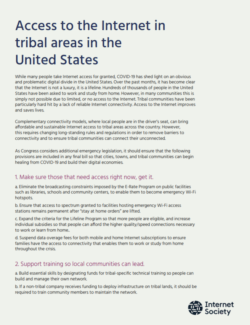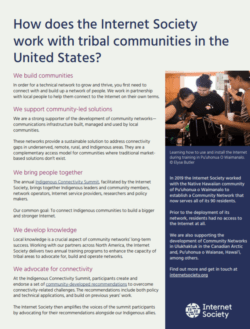While many people take Internet access for granted, COVID-19 has shed light on an obvious and problematic digital divide in the United States. Over the past months, it has become clear that the Internet is not a luxury, it is a lifeline. Hundreds of thousands of people in the United States have been asked to work and study from home. However, in many communities this is simply not possible due to limited, or no access to the Internet. Tribal communities have been particularly hard hit by a lack of reliable Internet connectivity. Access to the Internet improves and saves lives.
Complementary connectivity models, where local people are in the driver’s seat, can bring affordable and sustainable Internet access to tribal areas across the country. However, this requires changing long-standing rules and regulations in order to remove barriers to connectivity and to ensure tribal communities can connect their unconnected.
As Congress considers additional emergency legislation, it should ensure that the following provisions are included in any final bill so that cities, towns, and tribal communities can begin healing from COVID-19 and build their digital economies.
1. Make sure those that need access right now, get it.
a. Eliminate the broadcasting constraints imposed by the E-Rate Program on public facilities such as libraries, schools and community centers, to enable them to become emergency Wi-Fi hotspots.
b. Ensure that access to spectrum granted to facilities hosting emergency Wi-Fi access stations remains permanent after “stay at home orders’’ are lifted.
c. Expand the criteria for the Lifeline Program so that more people are eligible, and increase individual subsidies so that people can afford the higher quality/speed connections necessary to work or learn from home..
d. Suspend data overage fees for both mobile and home Internet subscriptions to ensure families have the access to connectivity that enables them to work or study from home throughout the crisis.
2. Support training so local communities can lead.
a. Build essential skills by designating funds for tribal-specific technical training so people can build and manage their own network.
b. If a non-tribal company receives funding to deploy infrastructure on tribal lands, it should be required to train community members to maintain the network.
3. Remove barriers to access.
a. Encourage technical solutions like community networks at state and federal levels. Amend legislation prohibiting or limiting the ability of these networks to expand.
b. Strongly encourage Dig Once policies to facilitate deployment of middle-mile fiber, particularly for highway construction.
c. Implement One Touch Make Ready policies to incentivize deployments in rural and tribal areas. Similarly, fast track permits to get middle-mile fiber to rural areas and
d. Ensure Native American governments and communities, and small municipalities, are not unintentionally excluded from federal funding programs due to eligibility constraints.
4. Make resources easier to access.
a. Make spectrum easier to access for community networks in rural unserved or underserved areas on a licensed, unlicensed, or shared/secondary use basis, particularly in areas within licensed allotments that operators are not using.
b. Extend the Tribal Priority Window for Education Broadband Service (EBS) by 180 days so that tribal entities have time to complete their applications once they reopen after stay at home orders are lifted.
c. Institute rolling approvals for applications to the EBS Tribal Priority Window so that communities do not have to wait until the end of the priority window to begin using this much-needed spectrum.
d. Include Tribal Priority Windows for all upcoming spectrum auctions where there is unlicensed or unused spectrum over tribal lands.
We’re all part of building a bigger, stronger Internet.
Now is the time to work together to ensure that everyone, everywhere has access to the critical resources the Internet provides. Our recommendations pinpoint simple, yet powerful steps we can take to ensure that, no matter where you live in the United States, you have the possibility to connect to the Internet.
By taking these steps, people will be able to access the necessary health, education and employment resources to not only survive, but also to thrive during these uncertain times.
How does the Internet Society work with tribal communities in the United States?
We build communities.
In order for a technical network to grow and thrive, you first need to connect with and build up a network of people. We work in partnership with local people to help them connect to the Internet on their own terms.
We support community-led solutions.
We are a strong supporter of the development of community networks— communications infrastructure built, managed and used by local communities.
These networks provide a sustainable solution to address connectivity gaps in underserved, remote, rural, and Indigenous areas. They are a complementary access model for communities where traditional market- based solutions don’t exist.
We bring people together.
The annual Indigenous Connectivity Summit, facilitated by the Internet Society, brings together Indigenous leaders and community members, network operators, Internet service providers, researchers and policy makers.
Our common goal: To connect Indigenous communities to build a bigger and stronger Internet.
We develop knowledge.
Local knowledge is a crucial aspect of community networks’ long-term success. Working with our partners across North America, the Internet Society delivers two annual training programs to enhance the capacity of tribal areas to advocate for, build and operate networks.
We advocate for connectivity.
At the Indigenous Connectivity Summit, participants create and endorse a set of community-developed recommendations to overcome connectivity-related challenges. The recommendations include both policy and technical applications, and build on previous years’ work.
The Internet Society then amplifies the voices of the summit participants by advocating for their recommendations alongside our Indigenous allies.

